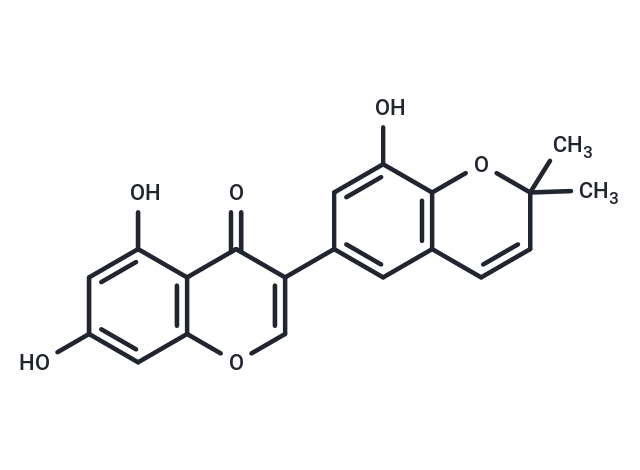Shopping Cart
- Remove All
 Your shopping cart is currently empty
Your shopping cart is currently empty

Semilicoisoflavone B, an isoflavone extracted from Kohlrabi, has anticancer activity and induces apoptosis in oral cancer cells by inducing ROS production and down-regulating MAPK and Ras/Raf/MEK signaling.

| Pack Size | Price | Availability | Quantity |
|---|---|---|---|
| 2 mg | $553 | 5 days | |
| 5 mg | $1,060 | 7-10 days | |
| 10 mg | $1,930 | 7-10 days |
| Description | Semilicoisoflavone B, an isoflavone extracted from Kohlrabi, has anticancer activity and induces apoptosis in oral cancer cells by inducing ROS production and down-regulating MAPK and Ras/Raf/MEK signaling. |
| In vitro | We evaluated the inhibitory effects of components from the root of Glycyrrhiza uralensis (G. uralensis) on aldose reductase (AR) and sorbitol formation in rat lenses with high levels of glucose as part of our ongoing search of natural sources for therapeutic and preventive agents for diabetic complications. In order to identify the bioactive components of G. uralensis, 5 prenylated flavonoids (Semilicoisoflavone B, 7-O-methylluteone, dehydroglyasperin C, dehydroglyasperin D, and isoangustone A), three flavonoids (liquiritigenin, isoliquiritigenin, and licochalcone A), and two triterpenoids (glycyrrhizin and glycyrrhetinic acid) were isolated; their chemical structures were then elucidated on the basis of spectroscopic evidence and comparison with published data. The anti-diabetic complication activities of 10 G. uralensis-derived components were investigated via inhibitory assays using rat lens AR (rAR) and human recombinant AR (rhAR). From the 10 isolated compounds, Semilicoisoflavone B showed the most potent inhibition, with the IC(50) values of rAR and rhAR at 1.8 and 10.6microM, respectively. |
| Molecular Weight | 352.34 |
| Formula | C20H16O6 |
| Cas No. | 129280-33-7 |
| Smiles | O=C1C(=COC=2C=C(O)C=C(O)C12)C=3C=C(O)C=4OC(C=CC4C3)(C)C |
| Relative Density. | 1.443g/cm3 |
| Storage | keep away from direct sunlight,store at low temperature | Powder: -20°C for 3 years | In solvent: -80°C for 1 year | Shipping with blue ice. | |||||||||||||||||||||||||||||||||||
| Solubility Information | DMSO: 50 mg/mL (141.91 mM), Sonication is recommended | |||||||||||||||||||||||||||||||||||
Solution Preparation Table | ||||||||||||||||||||||||||||||||||||
DMSO
| ||||||||||||||||||||||||||||||||||||

Copyright © 2015-2025 TargetMol Chemicals Inc. All Rights Reserved.